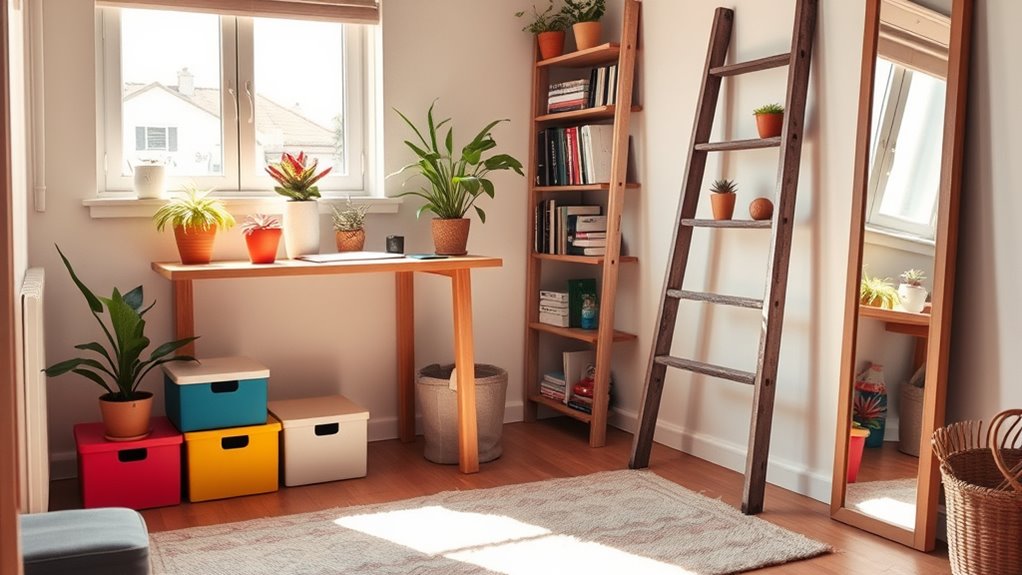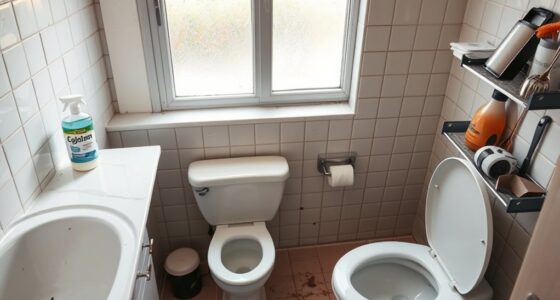To organize and clean small spaces, start with daily decluttering—just 15 minutes can make a big difference. Create functional zones for work, play, and relaxation, and keep items easily accessible. Maximize vertical storage by using higher shelves and hidden furniture storage. Be selective about new items, ensuring they serve a purpose. Regularly reassess your belongings to maintain a tidy environment. Stick around for more tips on transforming your space into an organized haven!
Key Takeaways
- Utilize vertical storage solutions like ceiling-high shelves and wall-mounted organizers to maximize limited space.
- Create functional zones to separate areas for work, play, and relaxation, enhancing usability in small spaces.
- Implement a “one in, one out” policy to maintain organization and prevent clutter from new acquisitions.
- Regularly reassess belongings, removing unused items and designating a specific area for donations or discards.
- Employ multi-functional furniture, such as ottomans with hidden storage, to optimize space efficiency and reduce clutter.
Embrace Daily Decluttering
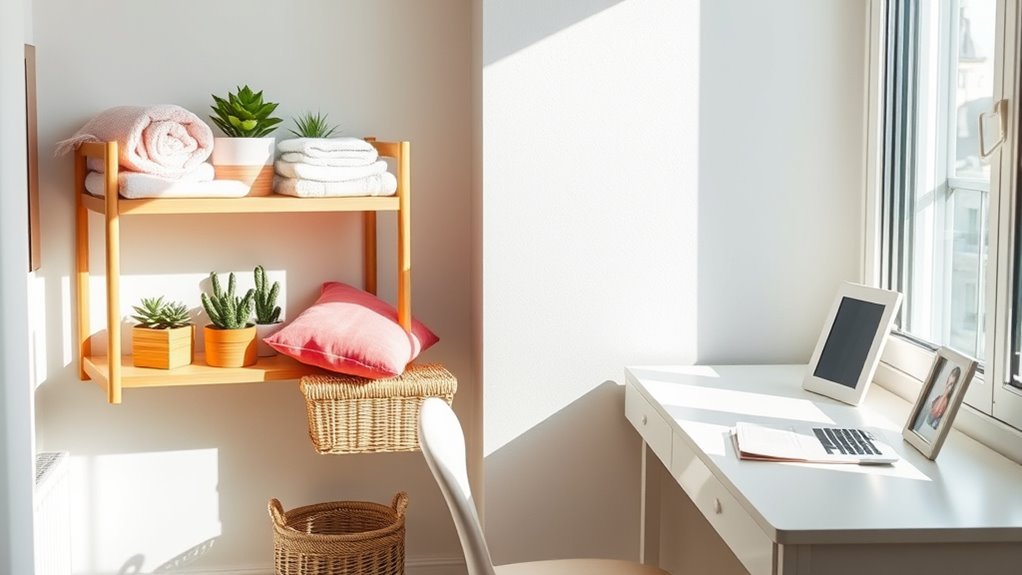
When you embrace daily decluttering, you can prevent overwhelming clutter from taking over your small space. Dedicating just 15 minutes each day to this practice helps keep your environment organized.
Implement a “sweep each night” routine, returning items to their designated places and ensuring a tidy atmosphere. Regularly assess your belongings, getting rid of items you no longer use or love, to maintain a clutter-free space.
Adopting a “one in, one out” policy when you acquire new items encourages mindful consumption. This habit not only minimizes clutter but also reduces the time needed for larger cleaning days.
Utilize vertical space effectively, and combine these organization ideas with your cleaning supplies for a more streamlined approach to managing your small space.
Create Functional Zones

Creating functional zones in your small space can substantially enhance both organization and usability. By designating specific areas for activities like work, play, and lounging, you can visually separate different functions, reducing clutter and improving flow. Use furniture arrangements to create natural boundaries and keep everyday items easily accessible within each zone. Store less frequently used items out of sight to maintain an organized environment. Color-coding or grouping similar items fosters streamlined organization.
| Zone | Purpose | Everyday Items |
|---|---|---|
| Workspace | Focused work tasks | Laptop, notebooks |
| Play Area | Relaxation and fun | Toys, games |
| Lounging Zone | Relaxing and socializing | Books, cushions |
This approach makes your small home feel more spacious and functional.
Maximize Vertical and Hidden Storage
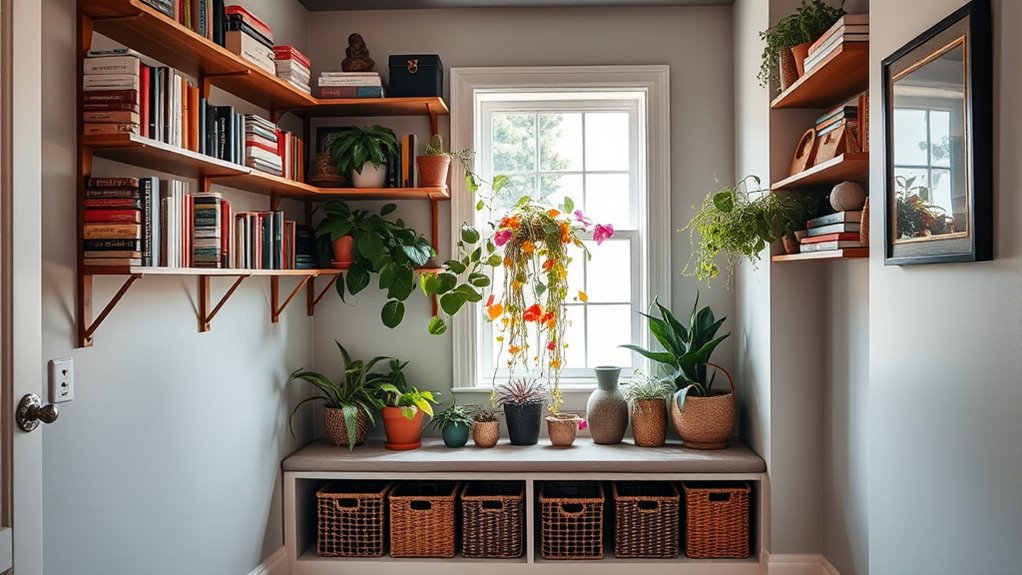
After establishing functional zones in your small space, it’s time to think about maximizing your storage options.
Start by utilizing vertical space; install shelves that reach the ceiling for extra storage without taking up floor room. Designate those higher shelves for items you don’t use often. Additionally, consider the zoning laws that may impact where you can place larger storage solutions or furniture. Incorporating shiplap walls can enhance the visual appeal of your vertical storage while maintaining a farmhouse aesthetic. Implementing multi-functional furniture can further optimize your space by providing additional storage options without sacrificing style.
Repurpose furniture like ottomans or benches to create hidden storage while providing seating. Incorporate wall-mounted storage, such as hooks and pegboards, to keep essentials accessible and surfaces clear.
Use shallow shelves or hidden compartments in cabinets to make the most of wasted space. Finally, store items in clear bins or labeled containers on shelves for better visibility and easier organizing. Additionally, consider using farmhouse kitchen textiles to enhance both the organization and aesthetic appeal of your small space.
This approach keeps your small space neat and functional.
Be Selective With New Items
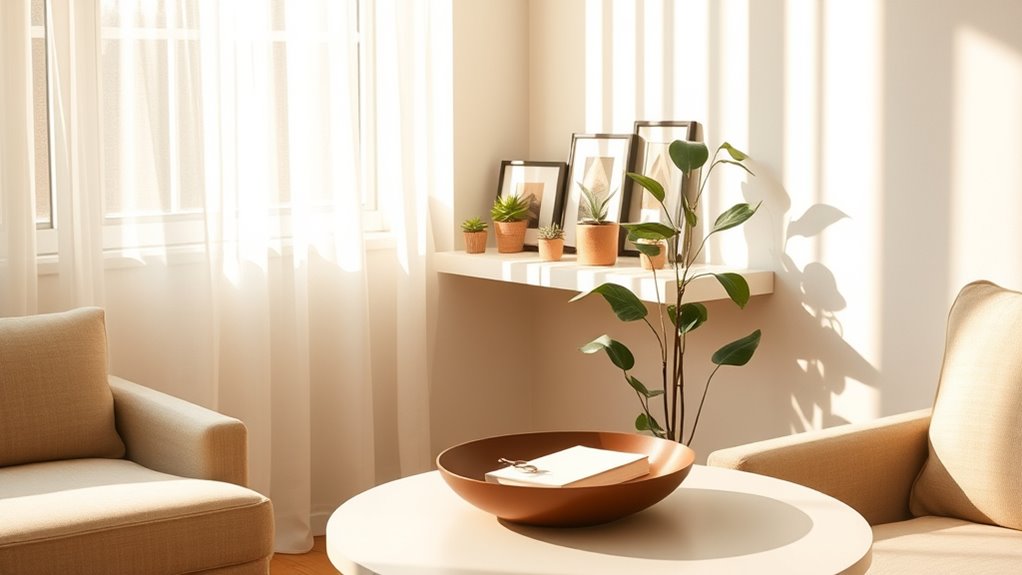
Being selective about new items is essential for maintaining an organized small space. Implement a “one in, one out” policy to guarantee that every new item you bring into your living room or craft supplies is balanced by discarding or donating an existing item.
Before accepting free items or gifts, think about their necessity and how they’ll contribute to decluttering your space. Prioritize quality over quantity when shopping; fewer high-quality everyday items can enhance your environment and reduce clutter.
Keep a wishlist for things you truly need, preventing impulse purchases. By consciously choosing what enters your home, you can better organize your vertical space and create a harmonious atmosphere that serves your lifestyle. Additionally, consider how regular outings can improve your overall puppy socialization experience, creating a balanced environment for both you and your pets.
Regularly Reassess Your Belongings
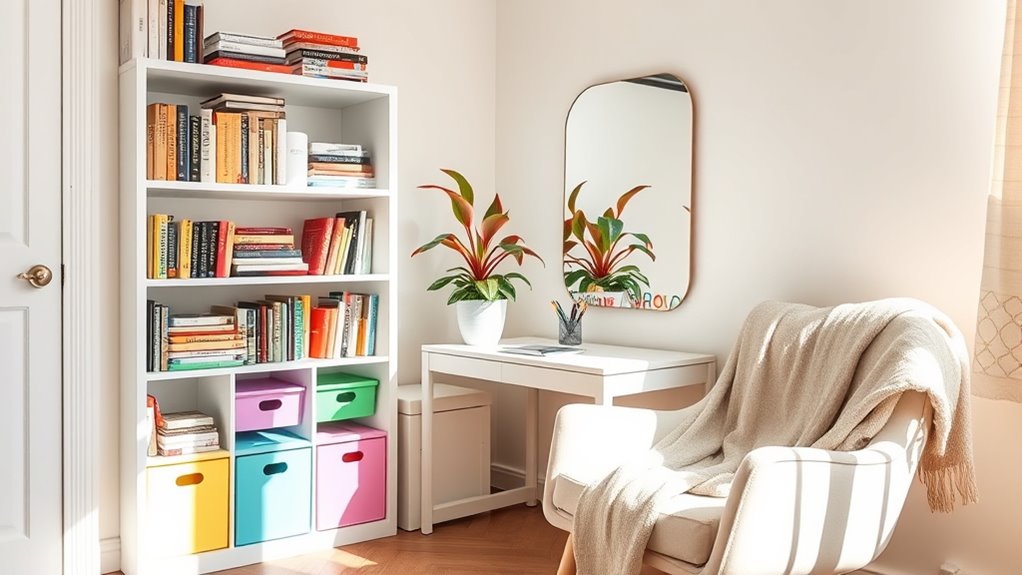
To keep your small space organized, regularly reassessing your belongings is key. Establish a routine, like monthly or quarterly evaluations, to identify items that create clutter.
During your assessments, consider the emotional or practical value of each possession, keeping only those that truly enhance your life. Implement the “one in, one out” policy when acquiring new items, promoting mindful consumption and consistent decluttering.
Consider the emotional and practical value of your belongings, keeping only those that genuinely enhance your life.
Create a designated area for donations or items to discard, making the process of letting go easier. By regularly reassessing, you can maintain a tidy environment and guarantee your small spaces remain functional and welcoming, free from unnecessary distractions and clutter. Additionally, energy consumption patterns can help you identify areas where efficiency may improve as you declutter.
Stay proactive, and your organized space will reflect your values and lifestyle.
Frequently Asked Questions
What Should I Remove First When Decluttering?
When you’re decluttering, start by removing items you haven’t used in the last year. These are often just taking up space.
Next, look for duplicate items, especially gifts that don’t hold significant value. Focus on things that don’t spark joy or serve a purpose; letting them go can lighten your load.
Finally, establish a one-in, one-out rule to maintain balance and prevent future clutter. Regularly reassess areas prone to accumulation, like entryways.
How Do You Clean and Organize a Small Room?
To clean and organize a small room, start by decluttering. Remove anything you don’t use or love.
Next, utilize vertical space with shelves or tall storage units to keep the floor clear. Incorporate multi-functional furniture for added storage.
Establish a daily cleaning routine to maintain order; just a few minutes each day can make a big difference.
Finally, use clear bins or labels to easily find and access your items.
How to Organize a Room With Too Much Stuff?
When your room’s bursting at the seams, it’s time to take action.
Start by decluttering ruthlessly; toss or donate items you haven’t used in years. Embrace the “one-in, one-out” rule to keep things manageable.
Use multi-functional furniture to hide clutter, and create zones for different activities with baskets or bins.
Regularly reassess what you have, adjusting your system as needed to guarantee your space stays organized and inviting.
How Do I Keep My Small Apartment Clean and Organized?
To keep your small apartment clean and organized, start by dedicating just five minutes daily to tidy up.
Use multi-functional furniture to maximize space, and consider a one-in, one-out policy for your belongings.
Create designated zones for different activities to help maintain order, and regularly declutter by evaluating items you haven’t used in the last year.
With these simple habits, you’ll find it easier to enjoy a clean and organized living space.
Conclusion
By embracing daily decluttering and creating functional zones, you can transform your small space into an organized haven. Did you know that people with organized spaces report 30% less stress? This highlights how a tidy environment can positively impact your well-being. Maximize vertical and hidden storage while being selective about new items to maintain order. And don’t forget to regularly reassess your belongings—it’s a simple yet powerful habit to keep clutter at bay. Enjoy your clutter-free oasis!

